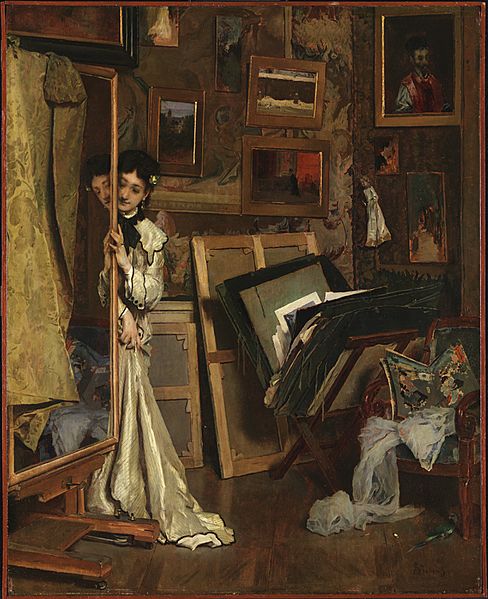Image: Stevens, Alfred, The Psyché (My Studio), ca. 1871

Description: Catalogue Entry: Trained in Brussels, Stevens finished his studies in Paris and made his career there. During the Second Empire (1852–70), he pioneered and perfected the domestic interior scene, which the Impressionists then adopted. He was inspired by Vermeer and Pieter de Hooch and often painted on wood panel. This painting, which once belonged to the poet Robert de Montesquiou, is one of several by Stevens of his studio with a model and sometimes the artist; its title refers to the mirror at the left. A full-length mirror with chassis was invented in the late eighteenth century and took its name, psyché, from the legend of Cupid and Psyche, a story that thematizes looking. Yet this is not an actual psyché but an easel with a mirror where the canvas would normally be, an analogue to a psyché suggesting that art is a reflection of life. A cloth partially covers the mirror, hiding the reflections of the studio. Focus instead is on the model, who may have interrupted her posing session to peer around the edge of the mirror, which reflects her head and hand. The artist hints at his own presence with the cigarette butt, ash, and match in the lower right corner. Nearby struts a small parrot, seemingly a reference to art’s mimetic function. The backs of canvases and portfolios of prints or drawings represent some of Stevens’s working materials. On a chair are Japanese prints, reminders of his love of objects and collecting; with his friends the Goncourt Brothers, Bracquemond, and Whistler, he was one of the earliest collectors of Japanese art in Paris. Among the small paintings on the wall is a sketch for his Salon picture What They Call Vagrancy (1854; Musée d’Orsay), a picture of social protest. Gallery Label: The French word psyché designates a full-length mirror that can be moved up and down or tilted on its chassis. Here, however, in a witty transposition, an artist’s model takes a break from posing and peeks around a looking glass that stands in for the canvas on an easel. The artist’s presence is implied by his cigarette butt, ash, and spent match on the floor. Beside them a parrot signifies the act of imitation—just as the bird mimics human speech, the artist imitates (or "mirrors") life. The bright Japanese prints in a portfolio reveal the artist’s interest in Asian art. Stevens was one of the early collectors of Japanese art and an advocate for Japonisme, the style that incorporated into European art elements of this "exotic" art, which had become increasingly available in the West since the treaty negotiated by Commodore Perry in 1854 opened Japan to international trade.
Title: The Psyché (My Studio)
Credit: Princeton University Art Museum
Author: Alfred Stevens
Permission: This is a faithful photographic reproduction of a two-dimensional, public domain work of art. The work of art itself is in the public domain for the following reason: Public domainPublic domainfalsefalse This work is in the public domain in its country of origin and other countries and areas where the copyright term is the author's life plus 100 years or fewer. You must also include a United States public domain tag to indicate why this work is in the public domain in the United States. This file has been identified as being free of known restrictions under copyright law, including all related and neighboring rights. https://creativecommons.org/publicdomain/mark/1.0/PDMCreative Commons Public Domain Mark 1.0falsefalse The official position taken by the Wikimedia Foundation is that "faithful reproductions of two-dimensional public domain works of art are public domain". This photographic reproduction is therefore also considered to be in the public domain in the United States. In other jurisdictions, re-use of this content may be restricted; see Reuse of PD-Art photographs for details.
Usage Terms: Public domain
License: Public domain
Attribution Required?: No
Image usage
The following page links to this image:

